#Boeing Starliner Calypso
Text
Le Starliner de Boeing a atterri, mais des questions subsistent après une mission imparfaite
Le Starliner de Boeing a atterri, mais des questions subsistent après une mission imparfaite
Le vaisseau spatial Starliner de Boeing a atterri en toute sécurité au Space Harbor de White Sands Missile Range.Photo: NASA/Bill Ingalls
Le Starliner de Boeing a atterri avec succès hier sur la surface sablonneuse du désert du Nouveau-Mexique, marquant l’achèvement du premier test de bout en bout sans équipage du vaisseau spatial. C’était un atterrissage parfait, mais la mission de six jours…
View On WordPress
#Boeing#Boeing Starliner#Boeing Starliner Calypso#Cosmos#Essai en vol orbital Boeing 2#Gizmodo#MAINTES FOIS#Point#Programme d&039;équipage commercial#Robert Hines#Rose#spacex#Station spatiale internationale#Steve Sitch#Vaisseau spatial#Vol spatial
0 notes
Text
Starliner Flight Readiness Review Slated To Start Today
Starliner lifts off on top of an Atlas V as it begins its Orbital Flight Test 2.Photo: Charles Boyer / ToT
According to NASA, Flight Readiness Reviews are starting today for the upcoming Boeing Crewed Flight Test of the Starliner Capsule “Calypso.” It is slated to launch with Butch Wilmore and Suni Williams aboard no earlier than May 6, 2024, at 10:34 PM EDT.
In those meetings, reviews of the…

View On WordPress
0 notes
Photo
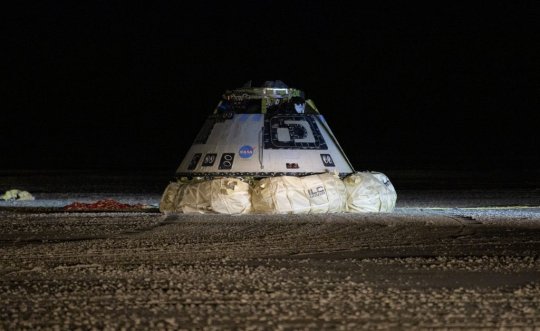
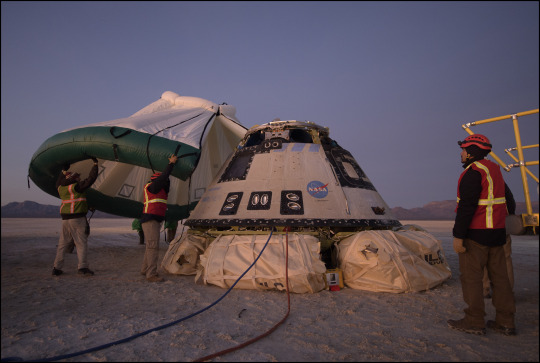
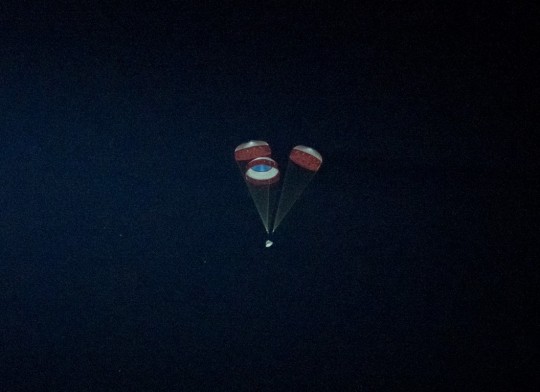

Calypso Starliner returns to earth after shortened Orbital Flight Test (December 22, 2019). Following a shortened, 49 hour, 21 minute flight in space, Boeing’s Starliner Calypso safely landed at the White Sands Space Harbor in New Mexico yesterday, December 22, 2019. A 55 second burn of the capsule’s Orbital Maneuvering and Attitude Control engines occurred at 7:23 am EST, with landing at White Sands 34 minutes later at 7:57 am. Ground and air-based images captured critical events in the capsule’s entry, descent and landing, including the successful deployment of all three drogue and main parachute canopies, heat shield jettison, and airbag deployment. Starliner’s November 4 pad abort test raised concerns when only two of the three parachutes unfurled, though Boeing stated that the capsule could land on two in an emergency without an additional risk to the crew. Recovery operations began once ground teams approached the capsule, installing an inflatable environmental shield and opening the spacecraft’s hatch. This marked the first time Boeing teams have practiced recovery operations on a space-flown capsule, and paves the way for procedures on future crewed flights.  Boeing recovery forces work to secure the Starliner Calypso after a successful landing at White Sands Space Harbor in New Mexico. Photo: NASA. NASA astronaut Suni Williams, who will command the same Starliner capsule that flew the OFT mission in late 2020, was given the honor by Boeing to name the returned capsule. She christened the spacecraft ‘Calypso’ after Oceanic explorer Jacques Cousteau’s famous ship. “A little homage to other explorers and the ships they rode on, I think we are going to call her ‘Calypso.’ Of course I love the ocean,“ said Williams, an avid diver as well as astronaut. "I love what the ocean means to this planet, we would not be this planet without the ocean. There is so much to discover in the ocean and there is so much to discover in space. It just seemed like a natural marriage.” Shortly after her statement, NASA Administrator Jim Bridenstein confirmed Williams’ choice, officially dubbing the capsule Calypso for the first operational Starliner mission, known as PCM-1. Calypso’s landing marks only the second time an orbital vehicle has landed at White Sands Space Harbor. The first was space shuttle Columbia following the STS-3 mission in 1982.  Boeing’s Starliner launches to orbit at 6:36am EST from SLC-41 at Cape Canaveral Space Force Station. Starliner lifted off from SLC-41 atop a ULA Atlas V N22 rocket at 6:36am EST Friday, December 20, from Cape Canaveral Space Force Station in Florida. The capsule was supposed to rendezvous with the International Space Station for a weeklong visit Saturday, but an 11-hour offset error in the Mission Event Timer caused an incorrect orbit to be achieved. This, in turn, depleted too much of Starliner’s fuel reserves, forcing NASA. and Boeing managers to call off the rendezvous. However, in a joint press conference Saturday between NASA and Boeing, managers stated that the remainder of the capsule’s systems were performing flawlessly and that most of the other test objectives of the OFT mission could be completed. Boeing will transport Calypso back to the Commercial Crew and Cargo Processing Facility at Kennedy Space Center within the next two weeks. Starliner will then undergo a thorough analysis of all its hardware to see the effects of orbital flight as well as to understand fully the root cause of the Mission Elapsed Timer anomaly. Boeing expects to have concluded this process by late spring next year, with the Crewed Fight Test to occur sometime over the summer. P/c: NASA.
#Starliner#OFT#Calypso#Boeing#Commercial Crew#NASA#White Sands#White Sands Space Harbor#Commercial Crew Program
86 notes
·
View notes
Link
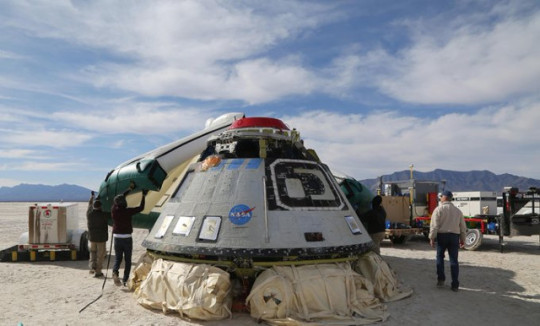
Boeing ha comunicato che i suoi ingegneri e tecnici stanno conducendo un esame approfondito della propria navicella spaziale CST-100 Starliner, atterrata il 22 dicembre dopo la fine prematura della sua missione Boe-OFT (Boeing Orbital Flight Test). L'esame include il recupero di tutti i dati registrati dai sistemi di bordo per ottenere risposte definitive sul problema che ha causato un errato inserimento in orbita circa mezz'ora dopo il lancio. Dopo l'atterraggio al White Sands Missile Range in New Mexico, il nome Calypso è stato proposto dall'astronauta Sunita Williams e rapidamente approvato, perciò sarà il nome ufficiale usato nelle prossime missioni, dato che la navicella è riutilizzabile.
1 note
·
View note
Text
Boeing’s Starliner Spacecraft Touches Down in New Mexico
Boeing & NASA - Orbital Flight Test (OFT) patch.
December 22, 2019
Image above: The Boeing CST-100 Starliner spacecraft lands under three main parachutes in White Sands, New Mexico, Sunday, Dec. 22, 2019. Photo Credits: NASA/Aubrey Gemignani.
At 7:23 a.m. EST, the spacecraft began its deorbit burn that puts Starliner on the right path to land at White Sands, New Mexico at 7:57 a.m. The service module has successfully separated from the crew module containing Rosie the rocketeer, an anthropometric test device whose sensors will provide teams on Earth valuable data for when crew members land in the Starliner.
Starliner landing
At 7:53 the drogue parachute will be released, pulling out the spacecraft’s three main parachutes that will slow the capsule to a safe landing on Earth a little more than an hour before sunrise in the southwestern desert.
youtube
First images of Starliner after landing and hatch opening
Boeing’s CST-100 Starliner spacecraft completed the first touchdown on land of a human-rated space capsule in U.S. history Sunday, Dec. 22, 2019, at White Sands Space Harbor in New Mexico, wrapping up the uncrewed Orbital Flight Test as part of NASA’s Commercial Crew Program.
Illustration of Boeing’s CST-100 Starliner spacecraft. Image Credit: Boeing
Starliner settled gently onto its air bags at 7:58 a.m. EST in a pre-dawn landing that helps set the stage for future crewed landings at the same site. The landing followed a deorbit burn at 7:23 a.m., separation of the spacecraft’s service module, and successful deployment of its three main parachutes and six airbags.
Inspecting the capsule, astronaut Suni Williams, who will command the next mission using the spacecraft, announced the crew had named it Calypso, after the ship captained by Jacque Cousteau in his ocean exploration.
Image above: The Boeing CST-100 Starliner spacecraft is seen resting on its airbags after it landed in White Sands, New Mexico, at 7:58 a.m. EST on Sunday, Dec. 22, 2019. Photo: NASA/Bill Ingalls.
Boeing’s Orbital Flight Test (OFT) was the maiden mission of the Starliner crew capsule to the International Space Station. Because of an off-nominal orbital insertion, Starliner was not able to reach the station.
Related articles:
Boeing suffers another setback ... In space, Starliner anomaly explained
https://orbiterchspacenews.blogspot.com/2019/12/boeing-suffers-another-setback-in-space.html
Boeing Starliner Orbital Flight Test Update
https://orbiterchspacenews.blogspot.com/2019/12/boeing-starliner-orbital-flight-test.html
Liftoff! Atlas V Clears the Launch Pad with Boeing’s CST-100 Starliner Spacecraft
https://orbiterchspacenews.blogspot.com/2019/12/liftoff-atlas-v-clears-launch-pad-with.html
Related links:
CST-100 Starliner: https://www.boeing.com/space/starliner/
Commercial Crew: https://www.nasa.gov/exploration/commercial/crew/index.html
International Space Station (ISS): https://www.nasa.gov/mission_pages/station/main/index.html
Images (mentioned), Videos, Text, Credits: NASA/Mark Garcia/NASA TV/Aubrey Gemignani/SciNews.
Best regards, Orbiter.ch
Full article
13 notes
·
View notes
Text
Boeing Spacecraft Returns to Earth After Aborted Mission
https://sciencespies.com/news/boeing-spacecraft-returns-to-earth-after-aborted-mission/
Boeing Spacecraft Returns to Earth After Aborted Mission
Boeing’s new Starliner unmanned spacecraft returned to Earth on Sunday, landing in the New Mexico desert in the United States six days early after a clock problem scuppered a rendezvous with the International Space Station. NASA hailed the aborted flight as a success, despite its failure to reach the ISS on what was meant to be a final dress rehearsal before a crewed mission. Images broadcast by NASA showed the spacecraft touching down, cushioned by airbags, after a pre-dawn descent slowed by three large parachutes.
“We had some challenges, but a lot of things did in fact go right,” NASA Administrator Jim Bridenstine told reporters, describing the landing as an “absolute bull’s-eye.”
“We did not make it to the International Space Station. We did not dock, but the spacecraft flew exceptionally well. We’ve got a lot of data to review.”
The Starliner capsule was launched Friday from Cape Canaveral in Florida, but shortly after separating from its Atlas V launch rocket, its thrusters failed to activate as planned, preventing it from reaching a high enough orbit.
The space station orbits at an altitude of about 400 kilometers (250 miles) above sea level.
As the craft had burned too much propellant, Boeing and NASA were forced to guide the Starliner back to Earth.
“Maybe it’s acceptable to go next step — fly the crew flight test, but we have to go through the data first,” Steve Stich, deputy manager of NASA’s Commercial Crew Program, said.
“We tested a majority of the core system of the vehicle… We had a little issue with the timer in the beginning.”
The test flight was a key part of NASA’s plans to end US dependence on Russia for space rides.
Its flight troubles also dealt a fresh reputational blow to Boeing, which faces a safety crisis in its commercial air division.
The company is reeling from two fatal crashes of its 737 Max airliner. The crashes, in October 2018 in Indonesia and in March 2019 in Ethiopia, claimed a total 346 lives.
Boeing plans to suspend production of the plane in January.
Capsule named ‘Calypso’
The Starliner was able to establish a communications link with the ISS, and to test its docking mechanism, solar panels, batteries, thrusters and heat regulation system.
Its heat shield protected the capsule during re-entry, when temperatures outside the vehicle rose to over 1,600 degrees Celsius (2,900 degrees Fahrenheit) due to friction.
Before its descent, the Starliner was orbiting at an altitude of 250 kilometres (150 miles) and traveling at over 28,000 kilometres an hour (17,400 mph).
In a test in November, only two of the three parachutes opened, although they proved sufficient for the landing.
NASA said the Starliner had landed in excellent condition and would now be refurbished ahead of a decision on whether to carry out another test flight or to trust that the vehicle was safe to carry astronauts.
The capsule has been named “Calypso” after French marine explorer Jacques Cousteau’s ship, NASA added.
Starliner’s first crewed flight had been scheduled for early 2020. That development was much-anticipated as NASA has been forced to rely on Russian Soyuz rockets to transport its astronauts to the space station since the Space Shuttle program was shuttered in 2011 after 30 years.
Under former president Barack Obama, NASA opted for a shift in how it operates.
Instead of owning the hardware, it hired private companies to take over, awarding Boeing and SpaceX billions of dollars to develop “Made in the USA” solutions.
The Crew Dragon, developed by SpaceX, is expected to be ready for launch next year.
NASA has committed to pay $8 billion (roughly Rs. 56,928 crores) to Boeing and SpaceX, which in return are to deliver six trips carrying four astronauts each from now to 2024.
Starliner carried a test dummy called “Rosie” after “Rosie the Riveter,” the star of a campaign aimed at recruiting women to munitions factory jobs during World War II.
Rosie was packed with sensors to verify the voyage would be safe for future teams of humans.
#News
1 note
·
View note
Text
Video Boeing baru menunjukkan perjalanan Snoopy ke Starliner Orbital Flight Test

Petualangan terakhir Snoopy sebagai "astronot terkenal dunia" kini telah terungkap dalam sebuah video baru dari Boeing.
Perusahaan aerospace pada hari Rabu (15 Januari) merilis rekaman yang direkam di atas Orbital Flight Test (OFT) pertama dari pesawat ruang angkasa kru komersial CST-100 Starliner. Meskipun misi Desember tidak berjalan sesuai rencana - kesalahan waktu mengakibatkan kapsul tidak dapat mencapai Stasiun Luar Angkasa Internasional - itu memang menerbangkan penerbangan pendek dua hari yang mencapai sebagian besar tujuan utama Boeing.
Misi juga dengan aman mengembalikan beagle hitam dan putih dari komik strip Charles Schulz setelah mengorbit Bumi 33 kali
Terbang di samping satu-satunya penumpang resmi Starliner yang tidak berpakaian - boneka antarikometrik berpakaian berpakaian (atau alat uji antropometri) bernama "Rosie" (setelah ikon Perang Dunia II Rosie the Riveter), Snoopy, dalam bentuk boneka mewah, berfungsi sebagai kendaraan " indikator nol-g. " Video itu memperlihatkan boneka itu mengambang tanpa bobot di ujung "tali" setelah Starliner memasuki orbit Bumi.
Boneka Snoopy pertama kali terungkap berada di Starliner sekitar satu jam sebelum diluncurkan pada 20 Desember. Penerbangan menandai kedua kalinya dalam beberapa bulan sejak Snoopy memasuki ruang angkasa. Pada bulan November, Snoopy plush style yang berbeda memulai debutnya di Stasiun Luar Angkasa Internasional dalam sebuah video yang menyertai balon karakter raksasa Snoopy di Parade Hari Thanksgiving Macy.
Kedua boneka Snoopy melanjutkan hubungan panjang yang dimiliki beagle kartun dengan program luar angkasa AS, pertama sebagai maskot keselamatan untuk program luar angkasa manusia NASA dan sekarang sebagai simbol untuk pendidikan sains, teknologi, teknik, dan matematika (STEM).
Snoopy di Starliner
Snoopy di atas OFT Starliner adalah boneka mewah setinggi 7,5 inci yang mengenakan pakaian antariksa kulit imitasi dengan syal merah dan topi komunikasi berwarna cokelat (atau seperti NASA menyebutnya, "topi Snoopy") di bawah helm gelembung plastik bening.
Dibuat oleh Hallmark, Boeing menyesuaikan boneka itu dengan tambalan misi Uji Penerbangan Starliner Orbital dengan desain yang sama yang melekat pada angkasawan biru Rosie
Snoopy adalah indikator zero-g kedua yang terbang di atas kendaraan kru komersial. Ketika SpaceX meluncurkan Crew Dragon tanpa awaknya pada misi demonstrasi pertamanya ("Demo 1") ke Stasiun Luar Angkasa Internasional, perusahaan itu mengejutkan publik dengan menerbangkan boneka mewah planet Bumi yang dibuat oleh Sahabat Surga.
Tradisi menerbangkan indikator zero-g, atau jimat, dimulai di Rusia dengan pesawat luar angkasa manusia pertama. Kosmonot Soviet Yuri Gagarin membawa serta boneka mainan kecil untuk ditonton saat melayang di atas wahana Vostok pada 12 April 1961.
Sejak itu, banyak komandan pesawat ruang angkasa Rusia memilih untuk melakukan hal yang sama, sering mengambil boneka atau mainan yang dipilih oleh anak-anak mereka. Karakter populer lain yang telah digunakan sebagai indikator nol-g termasuk R2-D2 dari "Star Wars," Olaf manusia salju dari "Frozen" Disney, Smokey Bear dari US Forest Service dan Red dari game mobile Rovio Entertainment "Angry Birds . "
Bangkit ke bawah
Video yang berdurasi hampir tiga menit ini termasuk klip singkat dari setiap tahap misi Starliner OFT, dari peluncuran fajar di Stasiun Angkatan Udara Cape Canaveral di Florida melalui touchdown dua hari kemudian di White Sands Missile Range di New Mexico.
Di antara, ada pemandangan dari kamera yang menunjuk ke dalam kapsul dan keluar jendela yang menunjukkan Bumi di bawah.
Snoopy mengendarai salah satu dari dua kursi Starliner yang dikonfigurasikan untuk misi OFT, diposisikan dekat tas penyimpanan dengan pakaian, makanan, dan persediaan yang ditujukan untuk stasiun ruang angkasa. "Rosie" diikat ke kursi di sebelahnya, merekam kekuatan g yang akan dialami astronot saat lepas landas dan mendarat
Terhubung oleh tambatan pendek, atau tali, Snoopy tetap dekat dengan kursi saat tembakan pendorong membuatnya bergerak. Video menunjukkan boneka itu memantul dengan lembut ketika Starliner mendarat di bawah tiga parasut utama dan di atas enam airbag. Pesawat ruang angkasa Boeing adalah kapsul awak pertama dalam sejarah AS yang dirancang untuk kembali ke darat (alih-alih jatuh ke laut).
Dengan penerbangan pertamanya selesai, OFT Starliner (dinamai pasca penerbangan "Calypso"), Rosie dan Snoopy dikembalikan ke Florida, di mana pesawat ruang angkasa sedang menjalani inspeksi dan akan diperbaharui untuk digunakan kembali di Kennedy Space Center. NASA dan Boeing juga telah mengadakan panel untuk menentukan penyebab kesalahan waktu dan apakah tes penerbangan orbital lain diperlukan sebelum meluncurkan uji penerbangan kru ke stasiun ruang angkasa
0 notes
Photo

Boeing’s CST-100 Starliner space capsule, which was christened Calypso after last month’s test flight, is wrapped in plastic for transport back to NASA’s Kennedy Space Center from White Sands Missile Range in New Mexico. (Boeing Photo)NASA says it’s working with Boeing to set up an independent investigation team to review last month’s less-than-perfect maiden flight…
0 notes
Photo

Calypso è il nome ufficiale della navicella spaziale CST-100 Starliner di Boeing, ora sotto ispezione appofondita https://diggita.com/v.php?id=1649286
0 notes
Text
Starliner "Calypso" Moves To Launch Pad For Vehicle Mating
Starliner outside of Boeing’s Starliner facility at Kennedy Space Center on April 16, 2024
United Launch Alliance and Boeing transported the CST-100 Starliner capsule from Boeing’s preparation facility aside the VAB early this morning, and transported it to SLC-41 for mating to its booster, an Atlas V N22. Launch of the Crewed Flight Test is scheduled for NET May 6, 2024, with an eight day…

View On WordPress
0 notes
Text
OPINION: 2019 - Numbers and Names
OPINION: 2019 – Numbers and Names
Highs and lows – 2019 had them all. Image Credit: Nathan Koga / SpaceFlight Insider
The past year has been a bit of a roller-coaster ride in terms of space exploration and utilization. But as the final days of 2019 came to a close, it’s clear that the last twelve months were defined by cold hard numbers. (more…)
View On WordPress
#Boeing#Calypso#Editorial#Falcon 9#Falcon Heavy#International Space Station#ISS#NASA#Op-Ed#Opinion#rocket#spacecraft#SpaceX#Starliner#Sunita Williams#The Range
0 notes
Text
0 notes
Text
Boeing Starliner Lands in New Mexico After Clock Error Prompts Early Return
Boeing’s new spacecraft, the CST-100 Starliner, safely parachuted to Earth on Sunday, landing atop inflated airbags before dawn at the White Sands Missile Range in New Mexico.
“It was an absolute bull’s-eye,” said Jim Bridenstine, the NASA administrator during a news conference after the landing.
The safe and seemingly flawless return of the capsule, which did not have any people aboard, provided an upbeat ending to a mission that started unhappily when a clock problem caused the spacecraft to deplete its propellant. A planned docking at the International Space Station was called off, and the capsule returned after only two days in orbit.
“Make no mistake,” Mr. Bridenstine said. “This did not go according to plan in every way we would have hoped. But it is also true that we got a lot of really good information so that we can keep making meaningful progress.”
The mishap on Friday added to a week of bad news for Boeing, which announced its commercial plane division would temporarily halt production of the 737 Max, its most popular passenger jet, which crashed in 2018 and 2019 and was subsequently grounded.
How the shortened flight affects the Starliner schedule and NASA’s plans to resume launching of astronauts on American rockets from American soil is not yet known.
Diagnosing and fixing the clock problem could add delays to the commercial crew program, NASA’s strategy of relying on private companies to build spacecraft to carry astronauts to and from the space station. It is already more than two years behind its original timeline.
Jim Chilton, senior vice president of the space and launch division at Boeing, estimated that the mission obtained enough data to fulfill 85 to 90 percent of the test objectives.
“The vessel looks great,” Mr. Chilton said. “They’re telling us there’s hardly any charring, perfectly level on her airbags. And that bodes really well for reusability.”
The Starliner capsule will be transported back to Kennedy Space Center in Florida, where it will be refurbished. Each capsule is designed to fly up to 10 times, and this one is currently scheduled to head to space again, this time with astronauts, in the second half of 2020.
Before then, Boeing is to fly another test flight, but with astronauts aboard.
Steve Stich, deputy manager of the commercial crew program for NASA, said teams from the agency and Boeing will spend weeks analyzing the data.
“To me, there’s good data out there that suggests that once we go through it, maybe it’s acceptable to go, next step, fly the crewed flight test,” Mr. Stich said. “But we have to go through the data first.”
Mr. Chilton agreed that it was too early to say whether the next Starliner flight will have astronauts aboard. “We’re not in position to propose that and we don’t propose it until we know the machine is worthy,” he said.
About half an hour before landing, thrusters fired for 55 seconds to drop the spacecraft out of orbit. That set off an automated choreography — jettisoning pieces no longer needed, deploying parachutes, inflating the airbags — that appeared to unfold flawlessly. The capsule touched down in the freezing desert before sunrise near a former space shuttle runway.
“It was just picture perfect,” Sunita Williams, the NASA astronaut who is to be the commander of the next flight of this capsule. She was at White Sands as part of the team examining the capsule after landing.
At the invitation of Boeing, Ms. Williams said she would like to name the spacecraft Calypso after the ship used by Jacques Cousteau to explore the oceans.
The return of the capsule on land was unusual, at least for NASA. All previous landings of its capsules — the Mercury, Gemini and Apollo programs of the 1960s and 1970s — were in the ocean. After all, you might be safer diving into water than an expanse of sand.
But Russian astronauts have always landed on solid ground, and that approach offers advantages. Salt water corrodes metal, which would complicate plans to reuse Starliner capsules for future missions. Also, a capsule hitting an ocean wave at the wrong angle could sink. (That is what happened during testing of Apollo capsules, requiring a revamping of the design.)
While NASA and Boeing had many reasons to celebrate on Sunday, the mission went awry in a puzzling way on Friday. Quite simply, Starliner got the time wrong.
When the spacecraft separated from the Atlas 5 rocket that lifted it to space, an incorrect clock, off by 11 hours, caused it to start firing its thrusters and try to get into the position and orientation where it thought it should be.
“She thought she was later in the mission,” Mr. Chilton said on Saturday, “and being autonomous, started to behave that way.”
Boeing does not know what went wrong.
“If I knew, it wouldn’t have happened” Mr. Chilton said. “We were surprised.”
The spacecraft’s software set its clock based on the time it received from the Atlas 5 rocket before launch, and it is still too early to tell how it pulled the incorrect information, said Mr. Chilton. He added that the problem was with the Boeing software, not with the rocket, which was built and operated by another company, the United Launch Alliance.
This flight did not have anyone on board, but NASA and Boeing officials insist that if astronauts had been in the capsule, they would have been safe. The astronauts might even have been able to take over manual control and send the spacecraft on the proper path.
Flight controllers were eventually able to send Starliner the correct time. They then performed a couple of thruster firings to raise its orbit to a circular one 155 miles above the surface. That was lower than the International Space Station, which is at an altitude of about 250 miles.
During its abbreviated time in orbit, the spacecraft’s propulsion, navigation and life support systems appeared to work well. Even though the Starliner did not go to the space station, flight controllers were able to test some of the systems needed to the rendezvous. That included establishing a communication link between the spacecraft and station and extending, then retracting a ring that would have attached to the docking port.
The two portions of the mission of greatest danger to astronauts — launch and return to Earth — have been demonstrated.
NASA still hopes to carry astronauts to orbit again in the first half of 2020, and has also hired another company, SpaceX, to take crews to the space station.
The problem with Boeing’s Starliner does not directly affect SpaceX’s capsule, Crew Dragon, which completed its first trip to and from the space station in March. But SpaceX has encountered its own hurdles and delays, and still has to complete tests of its parachute and conduct an in-flight test of its abort system, before it is ready to carry astronauts. That launch is currently scheduled for Jan. 11.
NASA has already talked to Russia about buying additional seats on the Soyuz rockets, which have been the only transportation available to astronauts to and from the International Space Station since 2011.
Sahred From Source link Technology
from WordPress http://bit.ly/2tBEzOa
via IFTTT
0 notes
Text
Boeing capsule returns to Earth after aborted space mission (Update)
https://sciencespies.com/space/boeing-capsule-returns-to-earth-after-aborted-space-mission-update/
Boeing capsule returns to Earth after aborted space mission (Update)
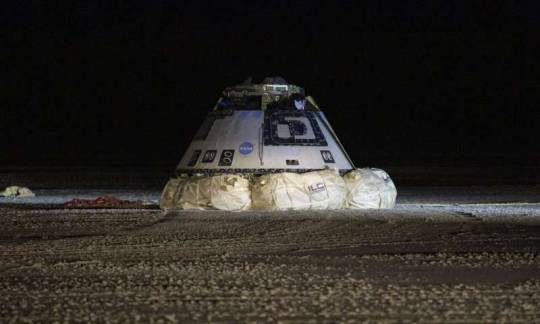

The Boeing Starliner spacecraft is seen after it landed in White Sands, N.M., Sunday, Dec. 22, 2019. Boeing safely landed its crew capsule in the New Mexico desert Sunday after an aborted flight to the International Space Station that threatened to set back the company’s effort to launch astronauts for NASA next year. (Bill Ingalls/NASA via AP)
Boeing safely landed its crew capsule in the New Mexico desert Sunday after an aborted flight to the International Space Station that could hold up the company’s effort to launch astronauts for NASA next year.
The Starliner descended into the Army’s White Sands Missile Range in the frigid predawn darkness, ending a two-day demo that should have lasted more than a week. A trio of red, white and blue parachutes popped open and airbags also inflated around the spacecraft to ease the impact.
“We pinpoint landed it,” NASA Administrator Jim Bridenstine said at a post-landing briefing.
The successful return capped a rocky start to a mission that was supposed to include a docking with the space station. Managers will review all the data before deciding whether to do another test flight or go straight to flying astronauts, said NASA’s Steve Stich.
After seeing this first test flight cut short and the space station docking canceled because of an improperly set clock on the capsule, Boeing employees were relieved to get the Starliner back.
Recovery teams cheered as they watched the capsule drift down through the air and make a bull’s-eye landing. The touchdown was broadcast live on NASA TV; infrared cameras painted the descending capsule in a ghostly white.

The Boeing CST-100 Starliner spacecraft lands in White Sands, N.M., Sunday, Dec. 22, 2019. Boeing safely landed its crew capsule in the New Mexico desert Sunday after an aborted flight to the International Space Station that threatened to derail the company’s effort to launch astronauts for NASA next year. (Aubrey Gemignani/NASA via AP)
As the sun rose, close-up views showed the large white and black capsule upright—with hardly any scorch marks from re-entry—next to a U.S. flag waving from a recovery vehicle. The astronauts assigned to the first Starliner crew—two from NASA and one from Boeing—were part of the welcoming committee.
“A beautiful soft landing,” said NASA astronaut Mike Fincke. “Can’t wait to try it out.”
It was the first American-made capsule designed for astronauts to make a ground landing after returning from orbit. NASA’s early crew capsules—Mercury, Gemini and Apollo—all had splashdowns. SpaceX’s Dragon capsule, which made its orbital debut last winter with a test dummy, also aims for the ocean at mission’s end.
Minutes after touchdown, top NASA and Boeing officials poured into Mission Control in Houston to congratulate the team. The newly returned Starliner also got a personalized name: Calypso, after Jacques Cousteau’s boat.

Boeing, NASA, and U.S. Army personnel work around the Boeing Starliner spacecraft shortly after it landed in White Sands, N.M., Sunday, Dec. 22, 2019. Boeing safely landed its crew capsule in the New Mexico desert Sunday after an aborted flight to the International Space Station that threatened to set back the company’s effort to launch astronauts for NASA next year. (Bill Ingalls/NASA via AP)
The capsule’s first trip to space began with a smooth rocket ride from Cape Canaveral on Friday. But barely a half hour into the flight, it failed to fire its thrusters to give chase to the space station and ended up in the wrong orbit.
The problem was with the Starliner’s internal clock: It did not sync up with the Atlas V rocket and was off by 11 hours, according to Boeing’s Jim Chilton.
The capsule burned so much fuel trying to orient itself in orbit that there wasn’t enough left for a space station rendezvous. Flight controllers tried to correct the problem, but between the spacecraft’s position and a gap in communications, their signals did not get through. They later managed to reset the clock.
Boeing is still trying to figure out how the timing error occurred. The mission lasted nearly 50 hours and included 33 orbits around the Earth, about 100 orbits fewer than planned.

Boeing, NASA, and U.S. Army personnel collect parachutes around the Boeing Starliner spacecraft shortly after it landed in White Sands, N.M., Sunday, Dec. 22, 2019. Boeing safely landed its crew capsule in the New Mexico desert Sunday after an aborted flight to the International Space Station that threatened to set back the company’s effort to launch astronauts for NASA next year. (Bill Ingalls/NASA via AP)
A test dummy named Rosie the Rocketeer—after Rosie the Riveter from World War II—rode in the commander’s seat. Also returning were holiday presents, clothes and food that should have been delivered to the space station crew.
Even though not all goals were met including a station docking, “in my eyes, it was a huge success,” said Boeing flight director Richard Jones.
There were no parachute problems this time. Last month, only two parachutes deployed during an atmospheric test because workers failed to connect a pin in the rigging.
“We didn’t do everything we wanted to do, but we don’t see anything wrong with this spaceship right now,” despite the timing error, Chilton said. He apologized to the six space station residents for not delivering their Christmas presents.
Boeing had been shooting for its first astronaut launch in the first half of 2020. This capsule is supposed to be recycled for the second flight with crew; each Starliner is built to fly in space 10 times.
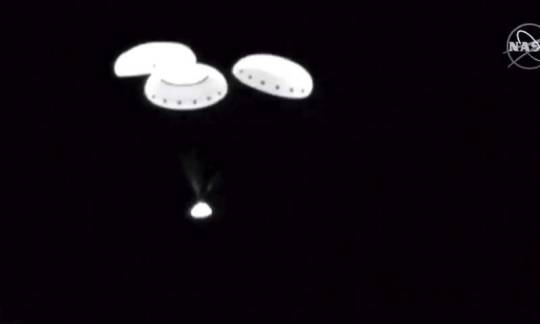
In this image taken from NASA video the Starliner capsule descends into the Army’s White Sands Missile Range, Sunday, Dec. 22, 2019, in White Sands, N.M. Boeing landed its crew capsule in the New Mexico desert Sunday after an aborted flight to the International Space Station that threatened to derail the company’s effort to launch astronauts for NASA next year. (NASA via AP)
The capsule will return to Florida’s Kennedy Space Center in two weeks for inspections and refurbishments.
“We’ve got a lot of learning in front of us,” Bridenstine said. “But we have enough information and data to where we can keep moving forward in a very positive way.
Despite its own setbacks, SpaceX remains in the lead in NASA’s commercial crew program.
SpaceX’s Dragon crew capsule successfully completed its first orbital demo last March. While the flight to the space station went well, the capsule exploded a month later on a test stand at Cape Canaveral.
If a launch abort test goes well next month, SpaceX could start launching NASA astronauts by spring and end a nearly nine-year gap in flying people from Cape Canaveral.
As its space shuttle program was winding down, NASA looked to private industry to take over cargo and crew deliveries to the space station. SpaceX kicked off supply runs in 2012. Two years later, NASA hired SpaceX and Boeing to ferry astronauts to the orbiting lab.

Boeing, NASA, and U.S. Army personnel work around the Boeing Starliner spacecraft shortly after it landed in White Sands, N.M., Sunday, Dec. 22, 2019. Boeing safely landed its crew capsule in the New Mexico desert Sunday after an aborted flight to the International Space Station that threatened to set back the company’s effort to launch astronauts for NASA next year. (Bill Ingalls/NASA via AP)
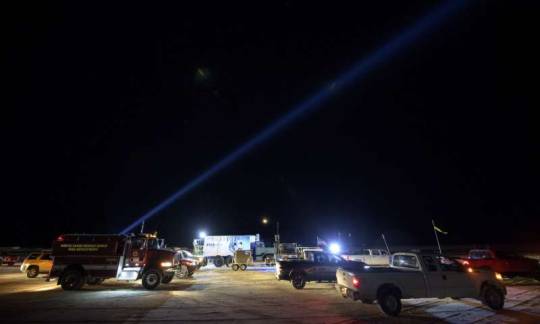
In this photo provided by NASA, Boeing, NASA, and U.S. Army personnel prepare for the Boeing CST-100 Starliner spacecraft landing in White Sands, N.M., Sunday, Dec. 22, 2019. (NASA/Bill Ingalls)

The Boeing CST-100 Starliner spacecraft descends into White Sands, N.M., Sunday, Dec. 22, 2019. Boeing safely landed its crew capsule in the New Mexico desert Sunday after an aborted flight to the International Space Station that threatened to derail the company’s effort to launch astronauts for NASA next year. (Aubrey Gemignani/NASA via AP)

The Boeing CST-100 Starliner spacecraft jettisons the heat shield before it lands in White Sands, N.M., Sunday, Dec. 22, 2019. Boeing safely landed its crew capsule in the New Mexico desert Sunday after an aborted flight to the International Space Station that threatened to derail the company’s effort to launch astronauts for NASA next year. (Aubrey Gemignani/NASA via AP)
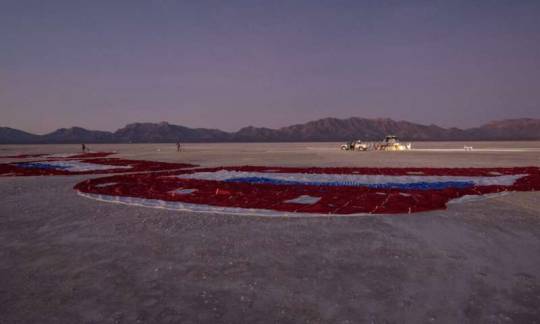
Boeing, NASA, and U.S. Army personnel work around the Boeing Starliner spacecraft shortly after it landed in White Sands, N.M., Sunday, Dec. 22, 2019. Boeing safely landed its crew capsule in the New Mexico desert Sunday after an aborted flight to the International Space Station that threatened to set back the company’s effort to launch astronauts for NASA next year. (Bill Ingalls/NASA via AP)

In this image taken from NASA video the Starliner capsule lands at the Army’s White Sands Missile Range, Sunday, Dec. 22, 2019, in White Sands, N.M. Boeing landed its crew capsule in the New Mexico desert Sunday after an aborted flight to the International Space Station that threatened to derail the company’s effort to launch astronauts for NASA next year. (NASA via AP)

In this long exposure photo, the United Launch Alliance Atlas V rocket carrying the Boeing Starliner crew capsule lifts off on an orbital flight test to the International Space Station from Space Launch Complex 41 at Cape Canaveral Air Force station, Friday, Dec. 20, 2019, in Cape Canaveral, Fla. (AP Photo/Terry Renna)

The Boeing CST-100 Starliner spacecraft lands in White Sands, N.M., Sunday, Dec. 22, 2019. Boeing safely landed its crew capsule in the New Mexico desert Sunday after an aborted flight to the International Space Station that threatened to derail the company’s effort to launch astronauts for NASA next year. (Aubrey Gemignani/NASA via AP)
SpaceX got $2.6 billion under NASA’s commercial crew program, while Boeing received more than $4 billion.
The goal was to launch NASA astronauts by 2017.
Because of delays, NASA is looking to buy another two seats on Russian rockets in 2020 and 2021 to guarantee a continuing U.S. presence on the space station. Even when private companies are regularly carrying up astronauts for NASA, the space agency always will reserve a seat for a Russian in exchange for a free U.S. seat on a Soyuz.
Over the years, these Soyuz rides have cost NASA up to $86 million apiece, with the tab totaling in the billions.
A recent audit by NASA’s inspector general found a Starliner seat will cost slightly more than that, with a Dragon seat going for just over half the price.
Explore further
Boeing’s crew capsule declared ready for 1st space flight
© 2019 The Associated Press. All rights reserved.
Citation:
Boeing capsule returns to Earth after aborted space mission (Update) (2019, December 22)
retrieved 22 December 2019
from https://phys.org/news/2019-12-boeing-capsule-earth-aborted-space.html
This document is subject to copyright. Apart from any fair dealing for the purpose of private study or research, no
part may be reproduced without the written permission. The content is provided for information purposes only.
#Space
0 notes